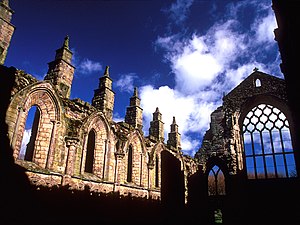Holyrood Abbey

Holyrood Abbey is a ruined Augustinian Abbey in Edinburgh, Scotland. The abbey (which is sited in the grounds of the Royal Palace of Holyroodhouse, which it predates) was built in 1128 at the order of King David I of Scotland.
Etymology of name
"Rood" is an old word for "cross", usually meaning the crucifixion cross of Jesus; thus the name is equivalent to "Holy Cross." A legend relates that King David I got into difficulties hunting in the woods and was saved by a stag with an illuminated cross between its horns, then vowed to build a church on the spot. The name is more commonly pronounced as Holly-rood as well as the less commonly used Holy-rood.
The legend of the founding of the Abbey
In 1127, while King David I was hunting in forests near Edinburgh, he suddenly found himself in danger from the antlers of a hart. Two brothers, Johannes and Gregan from the Barony of Crawford in Upper Strathclyde, saved the King. Grateful, he knighted the brothers and founded Holyrood Abbey the following year. From that day forward, that branch of the Crawford family adopted the crest of a buck's head erased with a cross of gold between the antlers to commemorate the founding of the Abbey. This family also adopted the motto Tutum Te Robore Reddam for "Our strength will give you safety." This crest was adopted by Clan Crawford after 1700 when this branch of the family ascended to the Chiefship through marriage into the existing Chief's lineage.
Usage and ruin


Since the fifteenth century, it has been the site of many royal coronations and marriage ceremonies. It also suffered from a number of attacks. During "The Rough Wooing" by Henry VIII of England, Edward Seymour as Earl of Hertford plundered the abbey in 1544, then as Protector Somerset led a raid causing great damage to the buildings. King James VII established a College of Jesuits in Holyroodhouse and had the Abbey converted in May 1688 to become a Roman Catholic chapel for the Order of the Thistle, with the Protestant congregation being moved to the new Kirk of the Canongate, then in November of that year when the Glorious Revolution brought in William II, Prince of Orange the people of Edinburgh broke in to plunder the kirk and the royal burial vaults. In 1691 the Kirk of the Canongate replaced the Abbey as the local parish church. Restoration work included the roof of the abbey being rebuilt in 1758, but the roof collapsed in a hurricane in 1768, leaving it as it currently stands, a ruin.[2][3]
Holyrood Abbey Church (Dalziel Place, Edinburgh)

There is still a Church of Scotland congregation named Holyrood Abbey, however this congregation uses a late-Victorian church building at Dalziel Place (with Dalziel pronounced dee-ell – because of the letter yogh) at the junction of Marionville Road and London Road, some distance from the old Holyrood Abbey. The church building was opened in December 1900 as Abbeyhill United Free Church.
Following the Disruption of 1843 in the Church of Scotland, part of the congregation of the Kirk of the Canongate left to form Holyrood Free Church. A new building was constructed in front of the Palace of Holyroodhouse. This congregation united with Abbeyhill United Free Church in 1915, henceforth using the Dalziel Place church buildings. The United Free Church of Scotland united with the Church of Scotland in 1929, the congregation henceforth being known as Holyrood Abbey Church. The building was extensively upgraded in 2006-2007.
Today, the Holyrood Abbey Church of Scotland congregation is well-known in Edinburgh for its Conservative Evangelical theology and tradition of expository preaching, developed by the Late Reverend James Philip MA (the congregation's former minister 1958-1997). Mr Philip was a friend of the Rev William Still, minister at Gilcomston South Church in Aberdeen from 1945 until 1997, the pioneer of expository preaching in the Church of Scotland. The current minister is the Rev Philip Hair BD.
The former Holyrood United Free Church building adjacent to the Palace was used for many years as a storeroom, but in 2003 was extensively renovated and reopened as "The Queen's Gallery" for art exhibitions from the Royal Collection.
References
- ^ Daniel, William S. (1852), History of the Abbey and Palace of Holyrood. Edinburgh : Duncan Anderson. facing p. 129.
- ^ "Palace of Holyroodhouse & Mary, Queen of Scots". Retrieved 2007-08-16.
- ^ "Reformation Scotland - Abbey and Palace of Holyroodhouse". Retrieved 2007-08-16.
- Crawfurd, George, "History of the Shire of Renfrew," Alexander Weir Publisher, Paisley, Scotland, 1782.
- Crawfurd, George, "Peerage of Scotland, Account of Nobility," George Stewart Publisher, Glasgow, Scotland, 1716.
See also
- Holyrood (disambiguation page)
- Abbeys and priories in Scotland
- Abbot of Holyrood, for a list of abbots and commendators
- Kirk of the Canongate
External links
- Template:Historic-scotland-link
- Catholic Encyclopedia's article on the abbey
- Holyrood Abbey Church, Dalziel Place
- Holyrood Abbey Church website
- 1120s architecture
- Category A listed buildings
- Church of Scotland churches
- Churches in Edinburgh
- Augustinian monasteries in Scotland
- Listed buildings in Edinburgh
- Listed monasteries in Scotland
- Scheduled Ancient Monuments in Scotland
- 1128 establishments
- Religious organizations established in the 1120s
- Royal Mile
- Christian monasteries established in the 12th century
